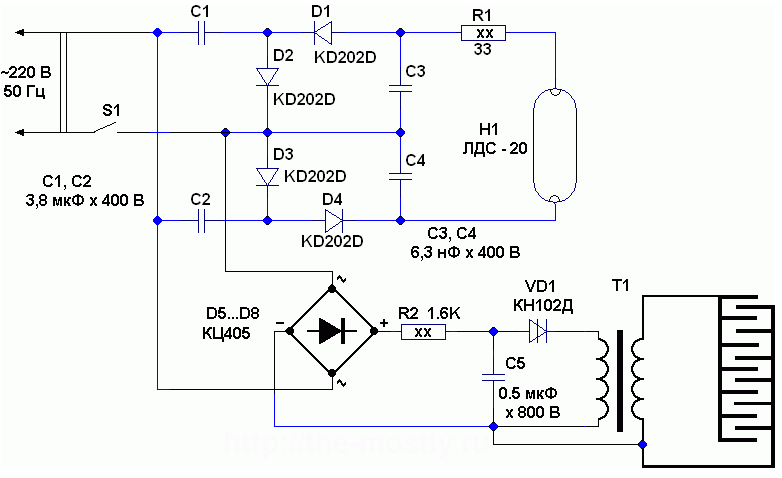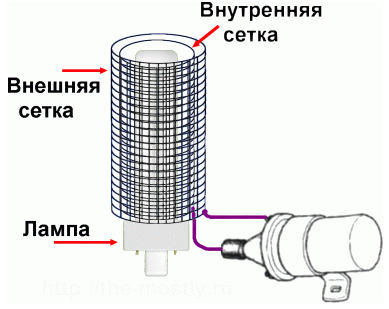
|
|
ENCYCLOPEDIA OF RADIO ELECTRONICS AND ELECTRICAL ENGINEERING A simple electronic insect trap. Encyclopedia of radio electronics and electrical engineering
Encyclopedia of radio electronics and electrical engineering / Home, household, hobby A simple electronic insect trap can be assembled using a 20 W fluorescent lamp of the LDS-20 type and a simple voltage converter. The lamp attracts insects with its light, flying on which they fall between two grids that surround the lamp and are under high voltage. In addition, the heat generated by the lamp also attracts insects. To power the fluorescent lamp, a voltage multiplier is used, which rectifies the mains voltage to a value of approximately 600 volts (without load). The upper arm of the multiplier (capacitor C1, diodes D1, D2) charges capacitor C3, and the lower arm (capacitor C2, diodes D3, D4) charges capacitor C4. The top capacitor is charged with a negative voltage, and the bottom capacitor is charged with a positive voltage. Since the capacitors C3 and C4 are connected in series, the voltage across them adds up and becomes sufficient to ignite the fluorescent lamp, and the current strength allows you to keep it burning. In such a lamp power circuit, both backlight lamps from the monitor and fluorescent lamps with burnt filaments can be used. From the rectifier (diode bridge D5 ... D8), a pulsating voltage with a frequency of 50 Hz is supplied to a voltage converter made on a VD1 dinistor, a capacitor C5 and a resistor R2. The load of the converter is the primary winding of the transformer T1. The voltage converter works as follows. Capacitor C5 is charged through resistor R2 with a pulsating voltage, and as soon as the constant voltage across the capacitor reaches a value of approximately 80 volts, the VD1 dinistor will open and capacitor C5 will quickly discharge through the primary winding of transformer T1. Such a converter is called a relaxation generator. In his circuit, the resistance of the resistor R2 is selected in such a way that the current flowing through it will not keep the dinistor open after the capacitor is discharged, therefore the dinistor will close and the process will repeat. The frequency of the converter depends on the parameters of the elements R2, C5, as well as on the response voltage of the dinistor VD1, and in this case it is several hundred Hertz. Since the number of turns of the secondary winding of the transformer T1 is many times greater than the primary, then the impulse voltage on it will be much greater, reaching several kilovolts. An ignition coil from a car, type B116 or similar, is used as a pulse transformer, in this case its high-voltage output is the upper output of the T1 transformer according to the circuit. Instead of an ignition coil, you can use a home-made transformer wound on a piece of a 400NN brand ferrite rod 80 mm long and 10 mm in diameter. The primary winding contains 30 turns of PEL-0,6 wire, the secondary - 1500 turns of PEL-0,08 wire, winding in 10 layers with careful insulation between the layers. Capacitors C1..C4 must have an operating voltage of at least 380 volts, capacitor C5 - at least 750 volts. Instead of a diode bridge (D5 ... D8), you can use diodes such as KD208A, KD212A or similar. High-voltage grids with a cell with a diameter of approximately 10..20 mm must be placed around the H1 lamp so that they form two cylinders, the distance between these grids should be slightly greater than the distance at which electrical breakdown occurs. For safety, the outer mesh of the trap must be connected to the housing of the ignition coil. The diameter of the inner grid must be sufficient to exclude electrical breakdown between the grid and the H1 lamp.
If a source of carbon dioxide is placed under this trap, such as the one used in the simplest mosquito trap made from a plastic bottle, then the efficiency of the electronic trap will increase significantly - more mosquitoes will flock to it. The scheme of an electronic insect trap can be greatly simplified if, instead of a fluorescent lamp LDS-20 and a voltage multiplier (resistor R1, capacitors C1 ... C1 and diodes D1 ... D4), a so-called "energy-saving" lamp with a power of 15 W is used, having built-in electronic ballast.
Machine for thinning flowers in gardens
02.05.2024 Advanced Infrared Microscope
02.05.2024 Air trap for insects
01.05.2024
▪ The blackest color for a BMW car ▪ We are afraid of snakes and spiders from birth ▪ The world's first mine hydroelectric power station was launched
▪ site section Measuring equipment. Article selection ▪ article Bargaining is inappropriate here! Popular expression ▪ article Do all fish spawn? Detailed answer ▪ article Carpenter. Standard instruction on labor protection ▪ article Extension coil. Encyclopedia of radio electronics and electrical engineering ▪ article Luminescent linear scale. Encyclopedia of radio electronics and electrical engineering
Comments on the article: Urij Everything is very well explained and the diagram is clear. But I'm still not entirely confident in my abilities, so I bought a ready-made exterminator Sititek Sadovy-M, at least I know that the child will not be shocked by the current. Sergei Malinovka Thanks a lot for the helpful information. I wish you all the best!
Home page | Library | Articles | Website map | Site Reviews www.diagram.com.ua |






 Arabic
Arabic Bengali
Bengali Chinese
Chinese English
English French
French German
German Hebrew
Hebrew Hindi
Hindi Italian
Italian Japanese
Japanese Korean
Korean Malay
Malay Polish
Polish Portuguese
Portuguese Spanish
Spanish Turkish
Turkish Ukrainian
Ukrainian Vietnamese
Vietnamese


 Leave your comment on this article:
Leave your comment on this article: